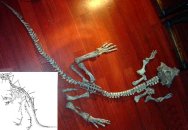| The null hypothesis that no dinosaur-age mammals were large fierce predators has been set aside by a new fossil discovery in (as one might guess) China, and (as you also might guess), Liaoning Province, the home of the feathered dinosaur discoveries. Dating to the Lower Cretaceous some 130 million years ago, the discovery of the mammalian fossil of Repenomamus giganticus renders to a myth the generally accepted hypothesis that Mesozoic mammals were cowering, nocturnal creatures that slinked about by night staying clear of the dinosaurs that ruled the land. The meter long Repenomamus giganticus may have resembled that modern-day badger, an extant creature with formidable predatory equipment. Concurrently, another mammal now named Repenomamus robustus, some half the size of Repenomamus giganticus, was uncovered at the same site with the bones of a baby Psittacosaurus in where its stomach would have been. The disarticulation of the Psittacosaurus suggests that Repenomamus tore its prey apart prior to devouring it, consistent with the mammal's sharp teeth and lack of molars. Repenomamusis is becoming known as the mammal that ate dinosaurs for breakfast. The new discovery is reported in the January 12, 2005 issue of Nature: Hu, Y., Meng, J., Wang, Y. & Li, C. Nature 433, 149-152 (2005)
| ||||||||
|
Fossil
Museum Navigation:
Home Geological Time Paleobiology Geological History Tree of Life Fossil Sites Fossils Evolution Fossil Record Museum Fossils |

